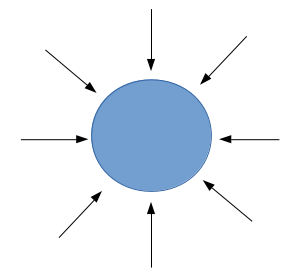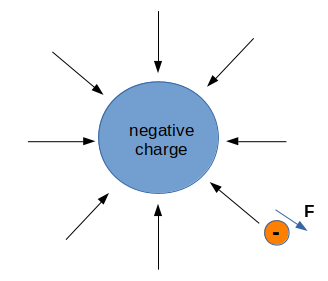A field, in physics, is a region of space where one object can affect another object without the two objects touching each other. The most familiar fields are gravitational and magnetic but now we need to gain some understanding of electric fields and their shapes.
Let’s start with a quick recap of what we know about gravitational fields.
The Earth has a gravitational field that holds us onto its surface. The same gravitational field also keeps the International Space Station in orbit above us.
Given that the overall force created by gravity is “downwards”, we can represent a gravitational field as a series of lines that point towards the centre of the object that is creating the field, like this…

You might realise that this is actually a vector diagram as it shows the direction of a force. It is not quite accurate because the force gets greater as the object gets closer to the Earth’s surface, but it is enough for us to move on to electric fields.
In the same way that a gravitational field shows a region where a mass will feel a force; an electric field shows a region where an electric charge will feel a force. There is a minor complication because we can have both positive and negative charges, whereas masses are always positive (we’re not going to mention anti-matter) but in other respects the two situations are very similar.
If we have a single negative electric charge then it will attract and nearby positive charge and the diagram shown above for a gravitational field could be redrawn and labelled to show an electric field, like this…

If the nearby charge were negative then the force would be repulsive (pushing the nearby negative charge away). You might think we would redraw the arrows to show the field in the opposite direction but that isn’t the case: the lines of an electric field always show the direction of force that would act on a positive charge. When we have the opposite charge, the electric field lines are in the same direction as before but the force is now in the opposite direction because we have two charges of the same type, so they will push each other apart, as shown below.

So this is our general rule: electric field lines always show the direction of force that is created by the object on a nearby positive charge.
If the two objects have opposite charges then the force between them will be attractive and the objects will be pulled together. But if the two objects have the same charge then the force between them will be repulsive and they will be pushed apart.
The electric field lines around a spherical object are radial (point towards or away from the centre of the object) – just like they are for gravitational fields.
There is a special case that you need to know about where the electric field lines have a different shape. This situation is shown below.

That’s all you need to know about electric fields. If you want a slightly different explanation, there is a good summary on p156 in your CGP Revision Guide.
For those of you who like to think beyond the GCSE course, the diagram below is a more complete representation of the parallel-plates electric field. You may have wondered why the simple drawing had no electric field on the other side of each plate and, as this diagram shows, you would be right to ask that question because there is in fact a field there too! (But we don’t mention it at GCSE!)

One final thought for you; the miniphysics website includes a number of multiple-choice tests that you might find helpful in your revision. They are based on the old O-Level syllabus, which is generally a bit more demanding than modern GCSEs, but you should be able to attempt most of the questions – and the others will stretch you a bit if you want to think more deeply about your physics learning. The quiz index is at https://www.miniphysics.com/o-level-physics-quiz.html
